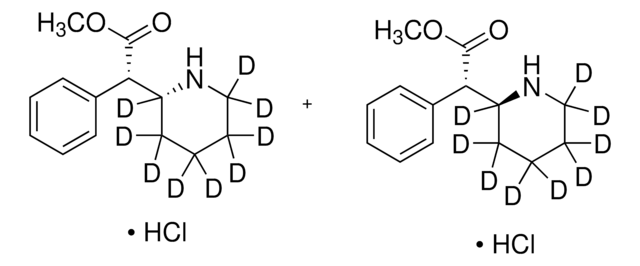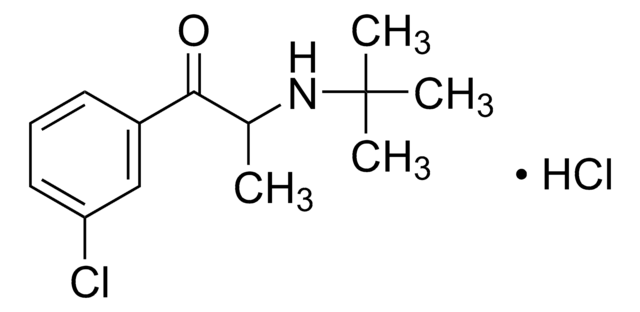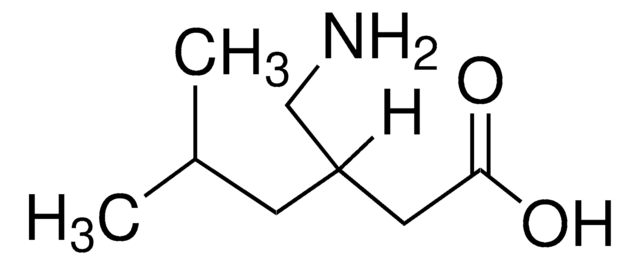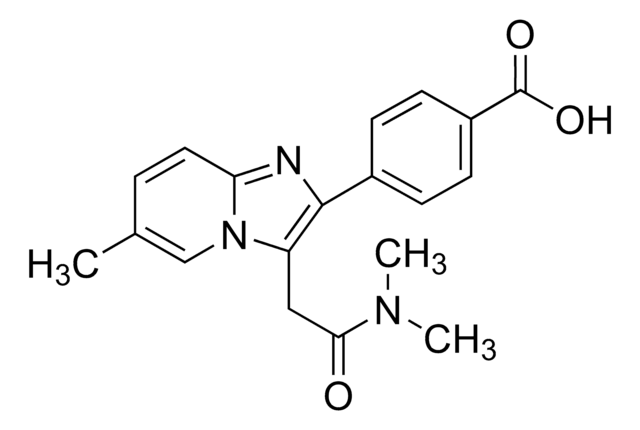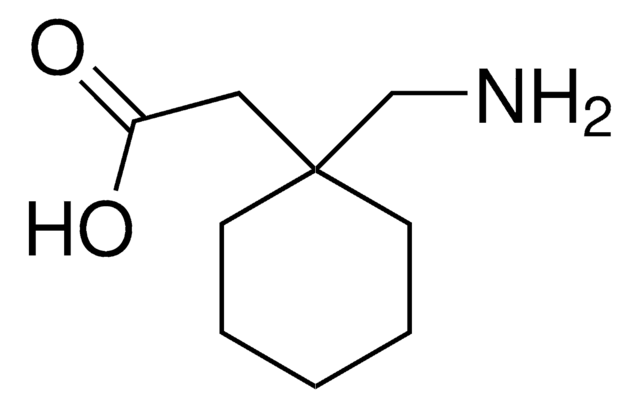R-011
Ritalinic acid hydrochloride solution
1.0 mg/mL in methanol (as free base), ampule of 1 mL, certified reference material, Cerilliant®
About This Item
Prodotti consigliati
Grado
certified reference material
Livello qualitativo
Forma fisica
liquid
Caratteristiche
Snap-N-Spike®/Snap-N-Shoot®
Confezionamento
ampule of 1 mL
Produttore/marchio commerciale
Cerilliant®
Concentrazione
1.0 mg/mL in methanol (as free base)
tecniche
gas chromatography (GC): suitable
liquid chromatography (LC): suitable
applicazioni
forensics and toxicology
Formato
single component solution
Temperatura di conservazione
−20°C
Stringa SMILE
Cl.OC(=O)C(C1CCCCN1)c2ccccc2
InChI
1S/C13H17NO2.ClH/c15-13(16)12(10-6-2-1-3-7-10)11-8-4-5-9-14-11;/h1-3,6-7,11-12,14H,4-5,8-9H2,(H,15,16);1H
SCUMDQFFZZGUQY-UHFFFAOYSA-N
Descrizione generale
Applicazioni
- Genotoxicity research in non-human primates: Ritalinic acid hydrochloride, a primary metabolite of methylphenidate, is used in genetic toxicology studies to evaluate potential genotoxic effects, aiding in the assessment of safety profiles for neuropharmacological treatments (Morris et al., 2009).
- Pharmacokinetics and mutagenicity studies: Ritalinic acid hydrochloride is used in dose-range and mutagenicity research. It helps in studying the pharmacokinetics and toxicological impact of methylphenidate, offering important insights into its safety and effectiveness in therapeutic applications (Manjanatha et al., 2008).
- Bioequivalence and food effect studies: In clinical pharmacology, ritalinic acid hydrochloride is instrumental in conducting bioequivalence studies of dexmethylphenidate, examining the influence of food on drug absorption and metabolism, crucial for optimizing drug administration protocols (Teo et al., 2004).
- Childhood pharmacotherapy: Research using ritalinic acid hydrochloride explores the effects of methylphenidate when administered with or without food, highlighting its impact on the plasma concentration of the drug and its acid metabolite, informing pediatric dosing guidelines (Chan et al., 1983).
- Hyperkinetic disorders treatment studies: Ritalinic acid hydrochloride supports pharmacokinetic studies in children with hyperkinetic disorders, aiding in understanding how methylphenidate behaves within the body to improve therapeutic strategies (Hungund et al., 1979).
Note legali
Prodotti correlati
Avvertenze
Danger
Indicazioni di pericolo
Consigli di prudenza
Classi di pericolo
Acute Tox. 3 Dermal - Acute Tox. 3 Inhalation - Acute Tox. 3 Oral - Flam. Liq. 2 - STOT SE 1
Organi bersaglio
Eyes,Central nervous system
Codice della classe di stoccaggio
3 - Flammable liquids
Classe di pericolosità dell'acqua (WGK)
WGK 2
Punto d’infiammabilità (°F)
49.5 °F - closed cup
Punto d’infiammabilità (°C)
9.7 °C - closed cup
Certificati d'analisi (COA)
Cerca il Certificati d'analisi (COA) digitando il numero di lotto/batch corrispondente. I numeri di lotto o di batch sono stampati sull'etichetta dei prodotti dopo la parola ‘Lotto’ o ‘Batch’.
Possiedi già questo prodotto?
I documenti relativi ai prodotti acquistati recentemente sono disponibili nell’Archivio dei documenti.
Articoli
As a major metabolite of methylphenidate (1, Ritalin), ±-threo-Ritalinic acid (2) is of clinical relevance.
Il team dei nostri ricercatori vanta grande esperienza in tutte le aree della ricerca quali Life Science, scienza dei materiali, sintesi chimica, cromatografia, discipline analitiche, ecc..
Contatta l'Assistenza Tecnica.
